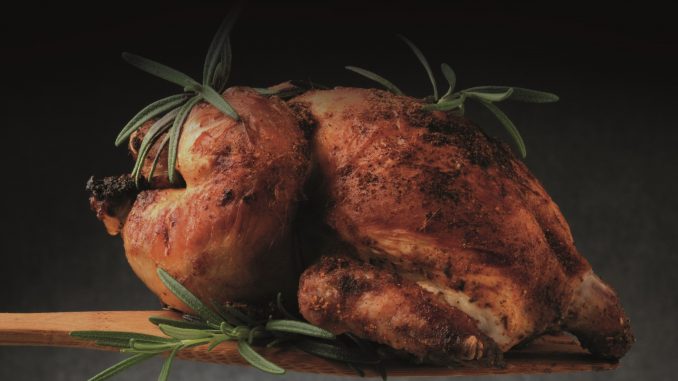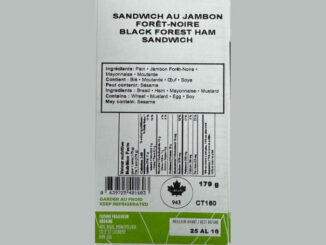
Bob Johnson
Rotisserie chicken is a well-established deli superstar because it answers the questions of convenience, nutrition and economy. However, new consumer trends bring additional room to grow the category.
Deli retailers have opportunities to capitalize on increasing consumer interest in greener protein alternatives and to make chicken dinner even easier than picking up a hard shell and walking it to the store’s cash register.
“With the continuing surge in having the supermarket associates do the shopping for the homemaker so he/she can stop-and-go for a quick pick up at the store, it is important that rotisserie chicken fits well with ongoing development,” says Tom Super, senior vice president of communications at the National Chicken Council, Washington, D.C. “For these shoppers, supermarket delis should consider better packaging, such as foil-lined bags that retain heat.”
Lucrative Formats
Another opportunity is to offer consumers, including the grab-and-go shoppers, even greater convenience by selling rotisserie chicken already cut into pieces.
“An up-charge of a dollar or two will likely be acceptable to these buyers,” says Super. “Since convenience is most important for these customers, stores should consider cutting the chicken into its various parts and, perhaps, giving the shopper the option to retain the back portion or not. Delis should test market offering in-store rotisserie chicken in a cut-up form with an appropriate up-charge.”
While consumers want even more convenience, a growing number of them also want chicken produced in ways that are more respectful of the birds, the environment or both.
Supermarket deli sales of natural or organic chicken increased 8% in the most recent report from the Madison, WI-based International Dairy Deli Bakery Association’s (IDDBA) What’s in Store 2020, while sales of conventional chicken dipped a modest 1%.
As a sign of the times D’Artagnan of Union, NJ, known for its high end duck, goose, pheasant and charcuterie products, recently teamed up with small Amish and Mennonite farmers to introduce Green Circle free range chicken, heritage varieties raised antibiotic and hormone free under certified human conditions.
“The Green Circle chicken is one of the fastest growing items in our portfolio because of the product quality and the taste,” says Terence Martin, vice president for retail sales at D’Artagnan. “They are free range and finished with vegetable scraps from local restaurants.”
D’Artagnan has been at the forefront of the movement to treat animals humanely since the company was founded in 1985, and although most of their products are high end, some are reaching the mainstream.
“Fairway Market is a customer of ours, and they started using antibiotic free rotisserie chicken in 2019,” says Martin. “We have some Green Circle rotisserie chickens in higher end independent stores.”

Selling Sustainability
The packaging industry is also offering alternatives that speak to the demand for a greener food supply.
“In March 2019, TC Transcontinental joined the Ellen MacArthur Foundation’s New Plastics Economy Global Commitment,” says Rebecca Casey, vice president marketing and consumer market development for Transcontinental, based in Lenexa, KS. “We have committed, by 2025, for 100% of our plastic packaging to be reusable, recyclable or compostable and to achieve a 10% use of post-consumer recycled content on average by weight across all plastics in our product offering. We are very serious about this commitment, and we believe it will be an exciting and inspiring journey.”
There is already a trend toward flexible packaging that is more resource efficient and offers an additional opportunity to use bold graphics.
“Packaging for rotisserie chicken, once looked at as a carrier, is now seen as a value-added alternative to the rigid, two-piece, domed container,” says Casey. “Our Hot N Handy Rotisserie Pouch is an attractive nine-color flexo-printed, leak resistant, microwaveable pouch with a built-in carrying handle and heavy-duty zipper. The proprietary venting and film application keep the rotisserie chicken fresh and moist. The pouch’s slim profile makes it both space-efficient for retailers’ in-store display and consumer storage of leftovers in their refrigerator.”
The sheer volume of sales makes it worth catering to relatively small, but growing, markets for rotisserie chicken that can be picked up at the curb, is already cut into pieces or comes from a cleaner, greener process.
“More than 1.87 billion young meat chickens weighing 4.25 pounds or less, liveweight, were produced in 2019, according to USDA reports,” Super says. “This is the weight category used for rotisserie chickens and accounted for 22% of the total chickens processed last year. It is estimated by the National Chicken Council that one-half or 950 million in this weight category were marketed as rotisserie chickens.”
Super expects the final tabulations will be even higher, as rotisserie chicken continues to trend.
“Rotisserie chicken continues its steady pace of gaining a more important share of America’s diet,” he says. “It is estimated that an additional 3% or 30 million chickens will be added to the 950 million sold in 2019. The vast majority of these rotisserie chickens will be sold at the delis in supermarkets and similar grocery stores.”
This is part of a continuing long-term trend toward choosing chicken as a source of protein that is both economical and generally healthy.
In 2017, 64.1 pounds of chicken per person on a boneless, edible basis were available for Americans to eat, compared to 54.3 pounds of beef, according to the U.S. Department of Agriculture’s August 28, 2019 Food Availability and Consumption report. “Chicken began its upward climb in the 1940s, overtaking pork in 1996 as the second most consumed meat. Since 1970, U.S. chicken availability per person has more than doubled. In 2017, 16.1 pounds of fish and shellfish per person were available for consumption.”

Smart Marketing
Rotisserie chicken is an established grab-and-go superstar because it can be the center of a meal that is easy, nutritious and economical but there may also be room to develop the snack market.
Chicken appetizer sales increased a vigorous 16% in the year ending March 24, 2019, according to IDDBA’s What’s in Store 2020, while deli dollar sales of sliced chicken declined slightly in the three years ending last June, and sales of chicken prepared entrées increased nearly 4%.
“Mealtime or snack time, deli consumers demand convenience with their purchase,” says Casey. “They don’t have the time to wait for someone behind the counter to serve up and package their choices; they want to find it in a grab-and-go type scenario. Retailers that set up small self-serve counters that offer a variety of fresh, high-quality prepared snacks will win this consumer loyalty.”
To minimize shrink and expand offerings, it is worth considering a system of using some of the rotisserie chicken in salads, sandwiches or other dishes.
“Rotisserie chicken salad in many supermarket delis outsells the traditional or home-style version,” says Super. “Supermarket delis should consider expanding the rotisserie roster to other products like sandwiches, pot pies, roll-ups and more.”
Another way for retailers to get a leg, or breast or thigh, up is to reliably offer rotisserie chicken over a long period of time.
“Consumers appreciate the value, convenience and taste that rotisserie chickens consistently deliver,” says Super. “Many supermarkets add to this appeal by guaranteeing a hot, delicious chicken will be available until, say, 8 p.m. This ‘you can count on us’ approach greatly helps the busy evening meal planners, especially when running late for preparing dinner.”
The core appeal for rotisserie chicken remains in its role as a convenient option for the center of the plate.
“Consumers are seeking step-saving solutions at mealtime, whether it is completely cooked dinner-time solutions or freshly prepacked and ready to cook,” says Casey. “Not only do they want their shopping and cooking time to be quick and easy, they are accustomed to having their foods fresh and healthy. The rise in consumer expectations of their in-store deli has heightened with all of the meal kit home delivery options that are now available.”
Dollar sales of all chicken dinner combo meals went up more than 20% the three years ending June 16, 2019, according to IDDBA’s What’s in Store 2020 trends, as consumers continue to look for ways to save time.“Many supermarkets do a good job at point-of-purchase of offering combination deals that feature tempting side dishes that enhance the serving of rotisserie chicken,” says Super. “Those types of offers would gain additional attention and acceptance by periodically having them in the weekly sales flyer and on-line product promotions, especially limited-time-only deals and seasonal flavored options. Managing the inventory of hot, ready-to-eat chicken is recognized as a challenge and is no doubt a reason why the flavors of rotisserie chicken remain somewhat limited. But a little food shopper research would likely indicate another flavor or two or three that consumers would be most willing to try.” DB



